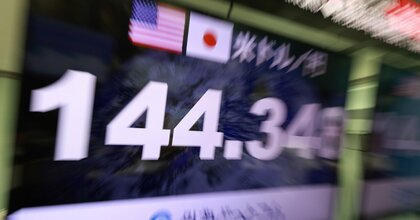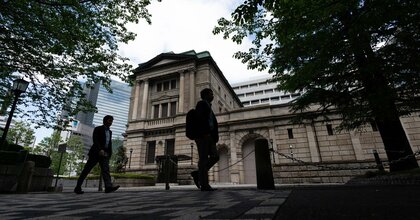30-year record
The yen began 2022 at about 115 per dollar, but on October 21, it had risen 32% to just around 152, the highest since August 1990. The yen hit a record low against the dollar of about 75 in October 2011, shortly after the 2011 earthquake and tsunami in northeastern Japan. Based on that benchmark, the Japanese currency has weakened by over 100%.
The main factor behind the yen’s depreciation against the greenback this year has been the widening interest rate gap between the U.S. and Japan. While the Federal Reserve continues to raise interest rates in an effort to curb soaring inflation, the Bank of Japan (BOJ) has maintained its massive monetary easing measures. As a result, the Japan-U.S. interest rate differential has widened, prompting moves to buy dollars and sell yen.
In addition to the widening interest rate differential, there is a widespread view in Japan that the weak fundamentals of the Japanese economy are prompting the yen to sell off. Japan, which once boasted the world's largest trade surplus, had now fallen into a trade deficit of about 11 trillion yen ($74.2 billion at current exchange rates) in the first half of fiscal 2022 (April to September), the largest since 1979 when comparable figures were available.
For more than 30 years, would-be experts have noted concerns about the growing budget deficit in Japan. Japan's outstanding government bonds exceeded 500 trillion yen in fiscal 2005, and its fiscal condition was said to be critical. However, 17 years later, in fiscal 2022, that figure is expected to reach the 1,000-trillion-yen mark. Macroeconomics suggests that the currencies of countries with large budget deficits tend to sell off.
Moreover, Japan's low growth is well known both at home and abroad. According to the International Monetary Fund's World Economic Outlook, the growth rate of Japan's gross domestic product is expected to be 1.7% last year and this year. Japan's low growth in this year may not be noticeable, as the U.S., China, and the Eurozone are also growing slowly, but these countries and regions recorded growth rates of 5% or higher last year. As a low-growth country, it is natural that demand for Japan's currency is low, and it is plausible that the yen's depreciation is a reflection of the country's sluggish economy.
Self-deprecating analysis
In Japan, there is a storytelling technique called jigyaku (self-deprecation), in which one invites laughter by highlighting their own shortcomings and faults and then humiliating themself. The Japanese who talk about the weak fundamentals of the Japanese economy and then look resigned and say that the yen's weakness cannot be stopped may be the masters of the art of jigyaku.
The view that the yen will continue to sell off and, by extension, the dollar will continue to strengthen due to the widening interest rate gap, and weak Japanese fundamentals may seem plausible without resorting to self-defeating talking points. However, long-term support and short-term views do not always coincide, not only in currency markets but also in market movements.
Looking at technical indicators on the dollar-yen chart, most trend indicators, like moving averages, suggest a further appreciation of the dollar, while most oscillator indicators suggest sideways movement.
With the dollar at a 20-year high and U.S. Treasury yields above 4% across the board, the view that the U.S. economy can make a soft landing is questionable. The strength of the U.S. economy last year and this year has only been supported by global fiscal stimulus, and there is a certain rationality in assuming that the probability of a U.S. economic crash will increase as the buffer of excess savings fades over time.
It is also important to remember that BOJ Governor Haruhiko Kuroda has only six months remaining in his term. His spectacular arrival in April 2013 as the standard-bearer of Abenomics led to historic monetary easing and the current depreciation of the yen. Opposition party lawmakers have now called on Kuroda to resign, and the BOJ's monetary policy has been criticized as being inconsistent with the Ministry of Finance's foreign-exchange market interventions in which it purchased yen.
Kuroda’s successor may not continue to ignore the voices criticizing the BOJ's loose monetary policy and continue the large-scale easing. Rather, it is natural to assume that he or she will take use their appointment as governor as an opportunity to reverse the pendulum swing back from the excesses of monetary easing.
Rather than assuming that the yen, which has weakened 30% against the dollar in just 10 months, will continue to rise, one should perhaps note that the potential ingredients for a yen pullback have strengthened. The dollar hit around 152 yen on October 21 but was quickly pushed back to the 144-yen level due to the subsequent intervention by the Japanese authorities. The daily dollar-yen chart on that day was a red candlestick with long wicks above and below, and the high of the week on October 24 failed to break the opening of October 21.
In Japan, it seems that questioning the effectiveness of the authorities’ yen interventions is seen as a sign of expertise, with a hint of jigyaku, but a straightforward look at the short-term chart shows that the interventions have increased the likelihood that the yen has peaked in the short term.
Of course, in the long run, it is hard to deny that the yen will continue to weaken as Japan's fundamentals erode further. However, a market that has moved too far can often show the exact opposite of the long-term trend in the short term. We should not forget that the plunging Turkish lira and Russian ruble rebounded sharply after their crashes, burning out the short positions.
Chiyo Hieda is the chief research officer of Crypto Capital, an asset management company focusing on crypto assets (formerly known as virtual currencies). The views expressed here are her own.











